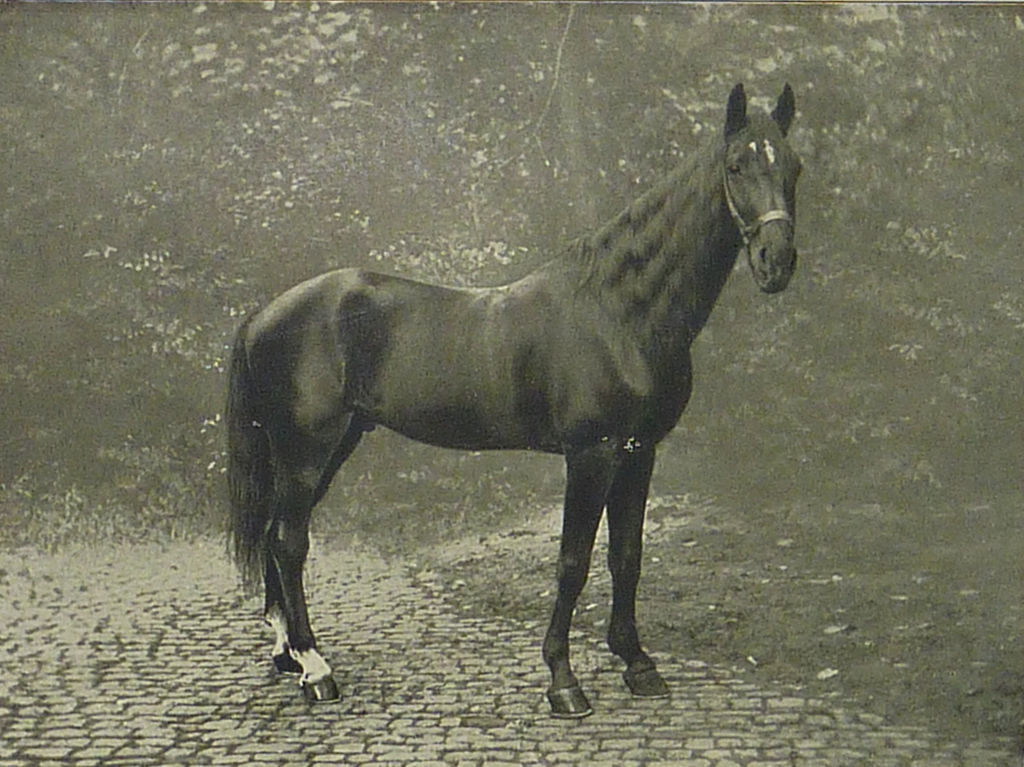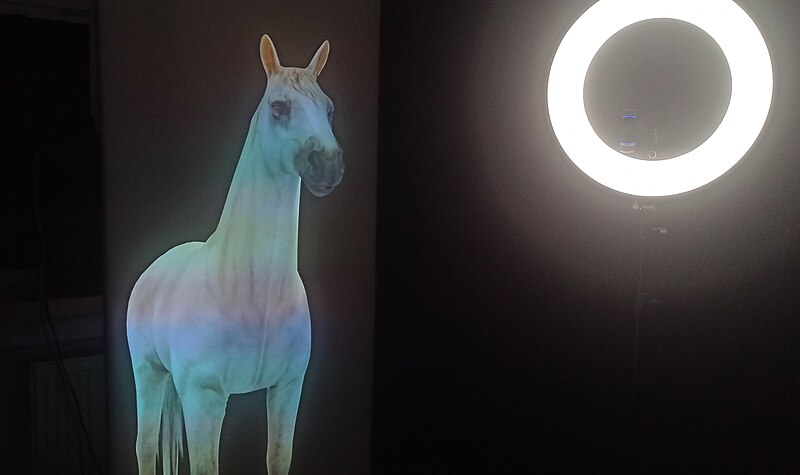Forever Hans

Der kluge Hans 1910, Karl Krall
We all owe Clever Hans an apology. To have your name forever associated with fraud and junk science is a poor legacy for an animal who really did demonstrate some incredible abilities - just not in the way that people wanted to believe. Sadly Hans’ fate in life was probably even worse than his tarnished reputation. Justice for Hans.
Hans the horse
The Orlov Trotter is the most famous Russian Horse, known for speed and stamina. The breed has a storied history in Russian equine culture. There are other famous Orlov Trotters for those who seek them, but their achievements are more along the lines of running very fast and siring hundreds of offspring, which to the layperson is perhaps pretty standard horsey fare.
In 1900 Wilhelm von Osten bought Hans in Russia. Hans was black with a “star” - a white marking between the eyes. At five years of age Hans was a young adult and Von Osten found him to be temperamental at first.
Hans the second
Hans had a predecessor, also named Hans. Von Osten bought the first Hans in 1888. After a while he observed the horse making independent decisions when pulling his carriage that suggested forethought and spatial reasoning. Inspired by this, Von Osten taught Hans directional commands such as left and right and numbers up to five. This Hans died suddenly of an intestinal obstruction before he could continue his lessons. Von Osten (by some accounts a phrenologist) preserved Hans’ skull, which he believed had contained an unusually large brain due to the curvature of its forehead.
Von Osten
Wilhelm von Osten trained as a mechanical engineer and became a teacher of mathematics at various gymnasiums (a school for boys around high-school age to prepare for university) around Germany. Eventually he settled in Berlin. By the time he had acquired the second Hans he was retired, which afforded him a lot of time for training.
Hans the student
Five years after the death of the first Hans, Von Osten taught Hans the second the same lessons, working patiently and methodically for several hours a day. Hans was able to surpass his predecessor, learning to indicate numbers by scratching with his right foot and answer questions by moving his head. He could apparently solve mathematical equations, differentiate between colours and musical notes, read German and identify people from photographs. Hans learned all these tricks in the space of two years.
Von Osten tried to engage scientific interest in Hans with little success. Eventually news of Hans began to spread after he placed ads in newspapers.
Clever Hans
Then came the peak of Hans’ fame. Von Osten gave daily demonstrations of Hans’ abilities in his backyard, which he never charged people to watch. The performances were managed “by gentle encouragement and frequent reward of bread or carrots”. This belies the story I thought I knew. I always pictured it as a carnival grift with the horse on a stage, tapping away until the tension broke in the audience. But von Osten was in earnest, and serious debate over the case played out in German newspapers for months.
The Berlin ‘Hans’ scandal... Now half of Berlin and part of the German Empire is under the spell of a phenomenon, the ‘thinking learned horse!’ I am really not exaggerating. In the Berlin papers, Hans appears almost daily. Even today, whole columns are dedicated to his ‘learning,’ albeit with question marks or skeptical remarks! Whoever reads this and wants to believe in the equally unnatural and nonsensical nonsense, believes it nonetheless.
Cologne People's Newspaper 724 from September 1, 1904.
Various public figures became interested in the demonstrations and sceptics were converted. News of Hans spread far and the street in front of von Osten’s house was jammed with traffic every day.
On both sides of the street, the well-known 'living wall', guards in large numbers, occupying the sidewalk — the first suspicion of the passerby pointed to a mass disaster. However, it was merely about keeping the uninvited admirers of the already well-known intelligent stallion in the neighborhood away from the house.
Tag 376 from August 12, 1904.
The Hans Commission
Von Osten welcomed scientific investigation of Hans’ abilities and actually petitioned the kaiser for this purpose. The German education board appointed a commission of 13 people, headed by philosophy professor Carl Stumpf, to investigate Hans. They found no evidence of tricks in the performances when Hans was able to perform his feats in the absence of von Osten and with a stranger asking the questions. However the commission could not provide a conclusive explanation of Hans’ apparent abilities, and recommended further investigation.
Hans debunked
Hans was tested further by Oskar Pfungst, who was a student of Stumpf at the time. And from Pfungst, the smoking gun:
(the) experiment was repeated at different times and in all there were 49 tests in which procedure was without knowledge, and 42 in which procedure was with knowledge. In the case of the former there were 8% correct responses, whereas in the case of the latter 98% of the answers were right. (...) Whenever the questioner knew the solution, nearly all of the horse's answers were correct; but when the answers were unknown to the questioner, the horse's responses were, with only a few exceptions, quite unsuccessful.
Clever Hans, the Horse of Mr von Osten, by Oskar Pfungst
Pfungst concluded that Hans was responding to subconscious cues in body language from the questioner: “These signs are minimal movements of the head on the part of the experimenter. As soon as the experimenter had given a problem to the horse, he, involuntarily, bent his head and trunk slightly forward”.
The public lost interest in Hans after this revelation. Von Osten was very upset about the results and allowed no further experiments. Until his death in 1909 he was convinced of Hans’ ability to think. After his passing, Hans became the property of the jeweller and merchant Karl Krall.
The demise of Hans
Krall continued training Hans along with a variety of other animals and published a book on animal intelligence (Denkende Tiere), detailing the experiments that von Osten had never written down. Krall had 10 other horses and two donkeys, so I like to think that Hans got to enjoy living with comrades for a few years.
In 1916 all of Krall’s horses were forcibly conscripted for the war. Nothing is known of Hans after that. At 21 years old, I wonder that Hans wasn’t considered geriatric enough to escape being sent to his demise. Hundreds of thousands of horses died in WW1. Hans may have been put to work pulling artillery or ambulances through mud and rough terrain. He might have been killed by weapons or succumbed to disease or starvation. In the end the wonderful horse of Berlin was just another smear in the meat grinder of war.
Hans in the afterlife
Pfungst’s research has had a great influence on the design of any kind of psychological experiment involving humans or animals. The “Clever Hans Effect” in psychology (and lately applied in the field of artificial intelligence) is probably why Hans and von Osten are still widely known today. But Hans lives on in some other curious ways.

AI art installation "Smart Hans" by Max Haarich, photo by Alejana78, used under CC4.0
One of the articles I read to research Hans is from a very earnest site about Icelandic Ponies. In the hearts of horse people, Hans is most definitely still a special horse. From Hestasaga’s about page: “does your dream horse exist in your phantasies, as a fairy tale, an adventure story or a poem?” Being a horse with a story is enough, whether historical or fictional. To see a horse is to see an angel on earth. Seriously I wish I believed in anything the way these people believe in horses. In these circles Hans will always be honoured.
The story of Hans is used to any number of ends by different narrators.
Business Hans
The website for a Kāpiti-based leadership programme involving horses (“astonishingly effective at giving accurate feedback on your leadership style”) plays fast and loose with the story of Hans, adding a cat and a badly-behaved bear to von Osten’s experiments. In this version Hans can detect the heartbeats of the audience. Hans and by extension all horses are cast as the noble lackey that will always tell it to you straight.
The incredibly-named Wally Bock blogs about the leadership lessons we can take from the Clever Hans story (your underlings can observe your behaviour). Interestingly the fabrication about the cat and the bear feature again. An article in Forbes finds Hans instructive for lessons about marketing and compares Pfungst’s experiment to the founding of Google. Educational consultants speculate about the Clever Hans Effect in human students.
It goes on and on. Yet in all of the takes I’ve read no-one can relate to being Hans, the sensitive observer with 98% accuracy in reading another species’ unconscious body language. This is the role of the dumb beast or the employee.
Hans the Influencer
If Hans lived today he would probably have a much gentler life. He was a hard worker and I think he would be very patient at doing multiple takes for social media. With the erosion of scientific authority any debunking probably couldn’t stick today, there would still be millions who see and believe. I do wonder if Pfungst would make short work of Billie the cat and Bunny the dog, who are famous for communicating with their owners via talking buttons. The things we want to believe animals are thinking have changed, with sentiment and comedy ruling the algorithms now (“love mom”, “dad upstairs poop”). Arithmetic doesn’t cut it anymore.
Perhaps we would have Hans the Empath, or Emotional Regulation Hans. His large, expressive eyes could gaze through the screen at an audience who feel unseen and misunderstood. His bond with von Osten could warm the hearts of the lonely. A short-form video flashes past, however fleeting, and something deep inside our bodies calls out, “horse, horse, wonderful horse”.
Sources and further reading
Clever Hans, by Oskar Pfungst https://www.gutenberg.org/files/33936/33936-h/33936-h.htm
Denkende Tiere, by Karl Krall https://ia801402.us.archive.org/21/items/denkendetierebei00kral/denkendetierebei00kral.pdf
PART 1: THE DISCOVERY OF WILHELM VON OSTEN https://www.hestasaga.com/en/2021/01/29/part-1-the-discovery-of-wilhelm-von-osten/
PART 2: THE WONDER HORSE ‘CLEVER HANS’ https://www.hestasaga.com/en/2021/02/05/part-2-the-wonder-horse-clever-hans/
https://de.wikipedia.org/wiki/Karl_Krall
https://de.wikipedia.org/wiki/Wilhelm_von_Osten
https://de.wikipedia.org/wiki/Kluger_Hans
https://en.wikipedia.org/wiki/Horses_in_World_War_I
https://en.wikipedia.org/wiki/Clever_Hans
Business garbage
https://impactlead.co.nz/2019/11/10/the-story-of-clever-hans/
https://leadchangegroup.com/leadership-lessons-from-the-story-of-clever-hans/
https://www.forbes.com/councils/forbescommunicationscouncil/2021/08/03/three-marketing-lessons-from-a-19th-century-horse/
https://robertkaplinsky.com/never-ask-question-horse-answer/
Artwork
Project Smart Hans, Max Haarich, 2022 https://www.uzupis.de/smart-hans/
Do you have a dream horse in your phantasies? Sound off below Purgies!
